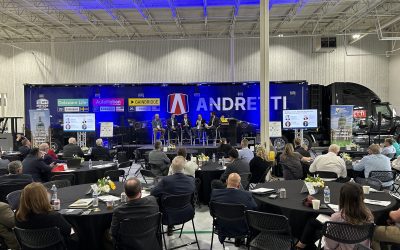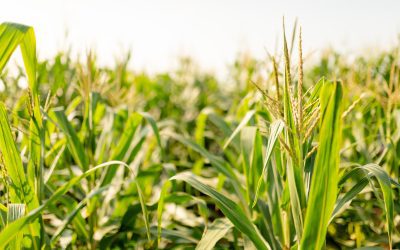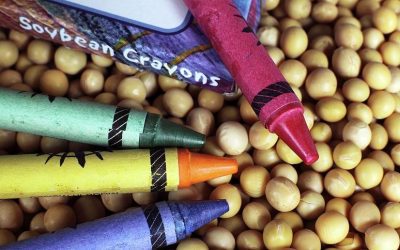BY ANN HINCH
Like an oak tree from an acorn, the foundation for a sizable project – such as securing a coveted $1.6 million grant from the National Science Foundation (NSF) – usually takes a while to grow and expand.
Sixteen years ago, Dr. Jennifer Tank of University of Notre Dame partnered with the Kosciusko County Soil and Water Conservation District (SWCD) and The Nature Conservancy to design a two-stage ditch to better prevent local runoff nutrients of farm fields from floating down feeder waterways to the Mississippi River and contributing to the hypoxic “dead zone” in the Gulf of Mexico.
The upgrade to the Shatto Ditch clarified runoff water – but it also led to the idea of expanding the ditch while planting cover crops including grasses, legumes and forbs, and measuring how the two practices combined might better reduce sediment, nitrogen and phosphorous runoff for improved water quality.
To carry out this next stage of their effort and fund the data collection, in 2013 the three partners added Indiana University (IU), the Natural Resources Conservation Service (NRCS), the U.S. Geological Survey and county surveyors to their team. Tank – Galla Professor in Notre Dame’s Department of Biological Sciences – and other researchers secured federal funding for the newly created Indiana Watershed Initiative through NRCS’ Regional Conservation Partnership Program.
During the five-year study in cooperation with some local landowners, this effort expanded cover crop use in the watershed from 13 percent of farmed acres to more than 62 percent, thanks in large part to direct payments to farmers for cover seeding. (In 2020, the NRCS reported this had dropped to 22 percent of acres after payments stopped.)
It also gave Tank and the IU researchers their next idea: Measuring how well using cover crops to trap carbon
dioxide, or CO2, in soil lowers emissions that contribute to climate change. Led by IU project director Dr. Kim Novick, the team applied twice to the NSF for a grant and received notification earlier this year that they were successful. Only 1 in 4 competitive proposals (those chosen for evaluation by the NSF) receive funding.
“The fact that they got this is very big,” said Joe Rorick, Conservation Cropping Systems Initiative agronomist and the Soy/Corn On-Farm Sustainability Programs and Research coordinator for Indiana Soybean Alliance (ISA) and
Indiana Corn Marketing Council (ICMC). He noted the award is also indicative of how important agriculture is to the
federal government and to the nation’s top scientists.
Critical checkoff dollars
Dr. Todd Royer, professor at IU’s O’Neill School of Public and Environmental Affairs, and Tank explained that it was
critical to be able to bridge the gap between when the NRCS funding ended in 2019 and 2022 when the NSF award was set to be available. Continuing support from ISA and ICMC checkoff dollars helped fill the gap during that time.
ISA, ICMC and the Walton Family Foundation first provided the necessary matching funds to secure the NRCS grant for five years.
“I think ISA and ICMC really got us the funding we needed to generate a lot of data that led to additional questions,”
Royer said. “We took those questions and partnered with other folks, mostly here at IU, to submit this grant (application) to the National Science Foundation, to expand the scope of the research from beyond just water quality and soil health to have a large social science component, an economics component and a new approach to measuring the effect of cover crops with eddy covariance towers.”
The tower is equipment that measures exchanges of CO2, water, energy and other trace gases between ecosystems and the atmosphere. They are expensive to erect. The new study will also use remote-sensing satellite data, which Royer said the team can use to help extrapolate their Indiana ground data across the entire Corn Belt to model how cover crops might be best distributed. The time and cost of data collection, Tank pointed out, is why there isn’t much on-the-ground data about carbon soil sequestration – yet.
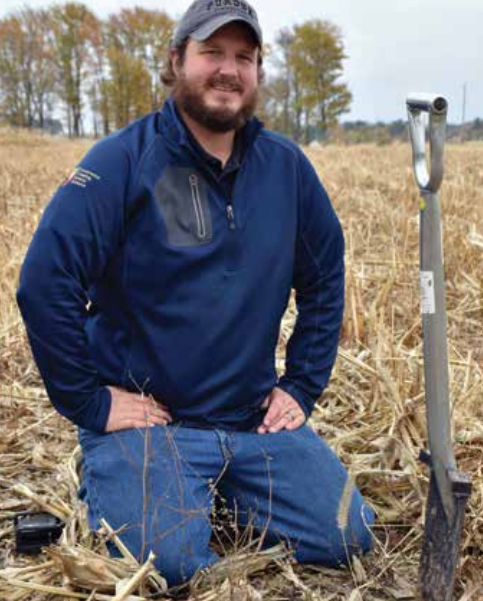
Joe Rorick, ICMC and ISA On-Farm Sustainability Programs and
Research coordinator, said the National Science Foundation
award is indicative of how important agriculture is to the federal
government and to the nation’s top scientists.
“What we’ve learned after a decade … is you have to sample year-round, and you have to take lots of samples,” she said, because the environment throws a lot of “noise” at researchers and their instruments, and it takes time and work to “tease out” the benefits of all these signals.
She called being able to continue monitoring the work they began in 2013 – even after the federal funding ended in 2019 – due to ISA/ICMC support “that kind of continuous bridge that these checkoff dollars are incredibly useful for.” She and Royer also said their support from the two organizations gave researchers the chance to build strong relationships with farmer landowners, since their universities are not land-grant and as such, rely heavily on privately owned farmland to study.
One of their supporters was Dave Rodibaugh, a Jasper County hog, soybean and corn farmer who cycled off the ISA Board of Directors last winter after nine years. He served as chair in 2020, as well as on the ISA’s Budget and Finance Committee. Tank remembered him as “always an encouraging voice when we’d come down to Indianapolis to present (our work) to the board.”
Rodibaugh appreciated the testing and scrutiny Tank and the team brought to their study for so many years to collect solid data that would be accepted by farmers, who are an evidence-driven set of professionals. He explained the project was an opportunity to shine a light on soil and water health and show farmers how they might improve their own lands.
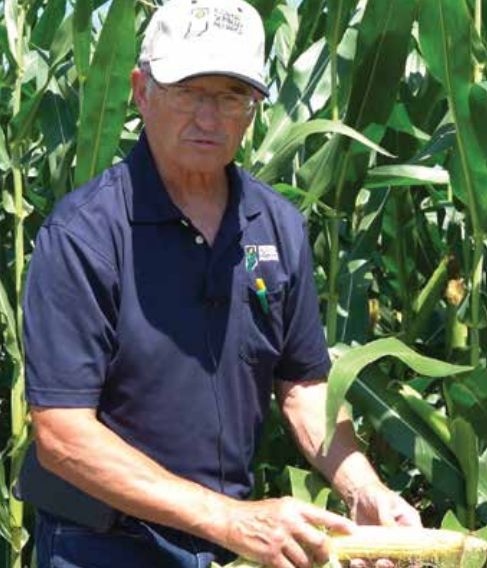
Dave Rodibaugh, a Jasper County hog, soybean and corn
farmer, appreciated the testing and scrutiny Dr. Tank and her
team brought to their study to collect solid data that would be
accepted by farmers.
He has used no-till in his fields for decades, then began learning more about cover crops through ISA meetings and related research, as well as hearing from farmers actually using cover. While he sees great value in planting it, he thinks it takes more investment to do and involves more risk than practices such as no-till.
“They have managed the cover crop research in a way that farmers have been able to learn from their findings, and find them useful,” Rodibaugh said of the research team.
“They’re both the best kind of people,” Rorick agreed, adding Tank and Royer have been good at reporting their findings, making themselves available for conversations and documenting their work in a way that helps farmers understand the data. “They’re very easy to work with.”
More than biology
The farmer investment into cover crops that Rodibaugh referenced is not lost on the NSF. In order to apply for the $1.6 million award, Tank and Royer said the Foundation required the applicants to go beyond crop and environmental sciences and consider other factors that play into ability of farmers to participate in such carbon sequestration.
“Estimates of the climate benefits achievable with cover crops are uncertain,” their abstract reads in part, “and it is not known how social and economic factors interact with environmental feedbacks to determine whether individual producers will adopt cover crops at the necessary scales.”
So, the new study that officially began on Oct. 1 expands into social science and economics. In addition to field
measurements, it will include surveys and focus groups to better understand how and why farmers decide to use cover crops – or not – and learn more about the decision-making process.
While surveying farmers isn’t a new concept, Royer said this will be done through the lens of the federal government’s new Climate Smart Agriculture initiative, which aims to increase agricultural productivity and income while building resilience to climate change and reducing greenhouse gas (GHG) emissions.
Could this program and the promise of an emerging market for farmers to sell “carbon capture” credits to offset large GHS emitters incentivize them to plant more cover crops? If the data show the practice works, perhaps more farmers will consider cover crops.
“Folks don’t make changes willy-nilly,” Tank said, “Particularly farmers. They study it and think about how it’s going to affect their operation” – not just in terms of budget and field use, but also changing any work habits and timing on the farm.
“This is an intentional focus by the National Science Foundation on taking this interdisciplinary approach to understanding these complex systems,” Royer explained.
“I don’t know if 10 years ago, Todd or I ever imagined that the team would build out like this to include an economist, two social scientists and other kinds of experts,” Tank added.
Headed by Novick, the O’Neill Chair, the team consists of Tank and Royer as well as IU’s Dr. Mallory Barnes, an expert in quantitative analysis and ecological data on scales of time; Dr. Shellye Suttles, an ag economist with a focus on food system sustainability and ag impact on climate change; Dr. Landon Yoder, who focuses on how farmers, government and society cooperate on ag production and conservation; and a number of postdoctoral and lab students.
“This research will provide actionable policy and management guidance through committed partnership with a broad community of public and private stakeholders,” the team’s abstract states, “ranging from individual farmers to
state- and national-level officials.”
“There’s a long way to go to actually measure how these practices impact carbon,” Tank said of using cover crops. “The biggest thing that drives us is bringing the real numbers to what the farmers want to know. I think this whole Climate Smart Agriculture push has real potential, but the farmers we work with want to see the real data. We’re not going to push something unless you can measure it.”
Royer added that this effort will hopefully turn into a minimum 10-year study, to be able to most- accurately measure change, because soil carbon accumulates slowly. Their study will continue to use the Kosciusko County watershed, as well as others to be determined.
“Our ultimate goal is to provide information that informs agricultural management and probably agricultural policy as well,” he said.
